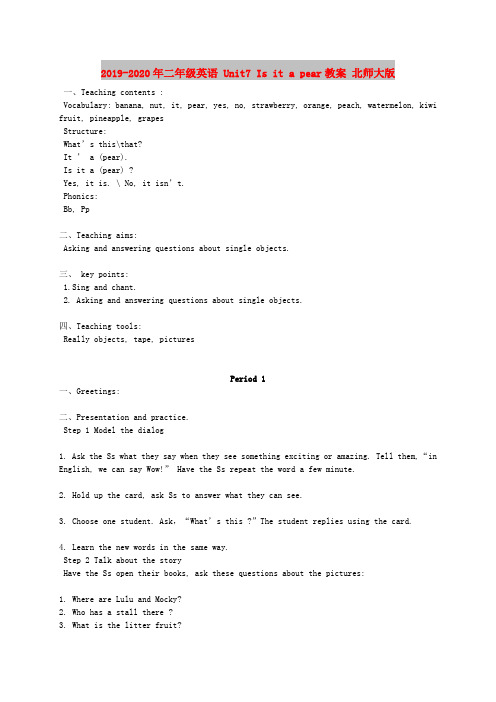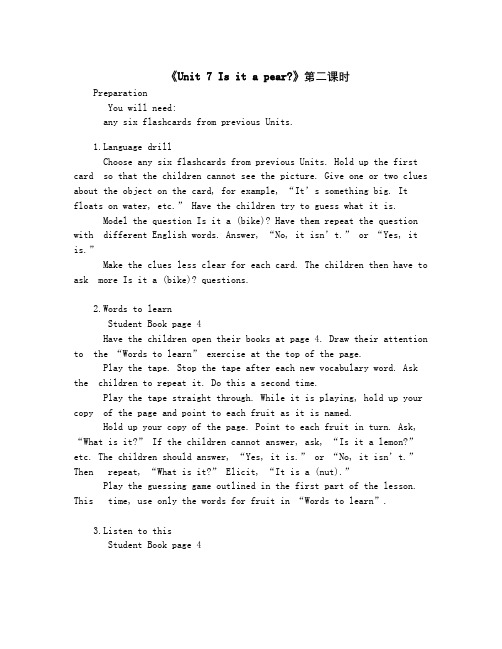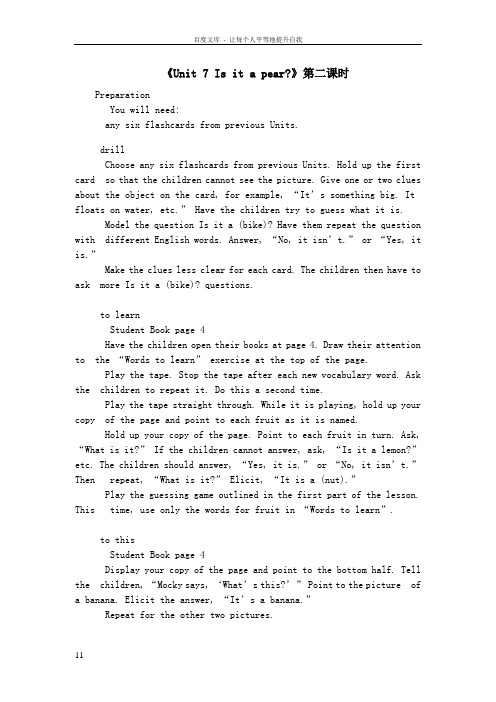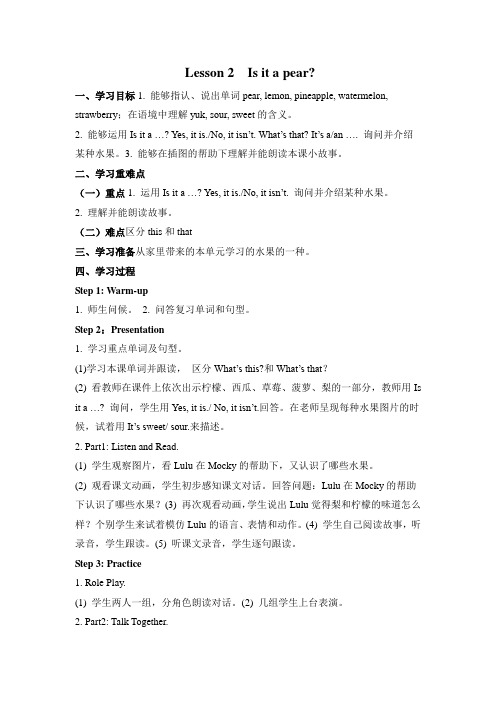北师大版小学三年级下册《Unit 7 Is it a pear》第一课时
- 格式:doc
- 大小:24.50 KB
- 文档页数:2

2019-2020年二年级英语 Unit7 Is it a pear教案北师大版一、Teaching contents :Vocabulary: banana, nut, it, pear, yes, no, strawberry, orange, peach, watermelon, kiwi fruit, pineapple, grapesStructure:What’s this\that?It ’ a (pear).Is it a (pear) ?Yes, it is. \ No, it isn’t.Phonics:Bb, Pp二、Teaching aims:Asking and answering questions about single objects.三、 key points:1.Sing and chant.2. Asking and answering questions about single objects.四、Teaching tools:Really objects, tape, picturesPeriod 1一、Greetings:二、Presentation and practice.Step 1 Model the dialog1. Ask the Ss what they say when they see something exciting or amazing. Tell them,“in English, we can say Wow!” Have the Ss repeat the word a few minute.2. Hold up the card, ask Ss to answer what they can see.3. Choose one student. Ask,“What’s this ?”The student replies using the card.4. Learn the new words in the same way.Step 2 Talk about the storyHave the Ss open their books, ask these questions about the pictures:1. Where are Lulu and Mocky?2. Who has a stall there ?3. What is the litter fruit?4. Does she like it?T: We are going to talk about the story.1. Hold up a card. Say,“What’s this ?”Elicit the answer,“peach”.2. Repeat this for pear, orange, and nut.Step 3 Story1.T: We are going to meet some new friends.Play the tape once without stopping.2.Play the tape again, pausing after each picture. Have the Ss repeat each sentences after hearing it on the tape.3. Divide the class into two groups. One group will be Mocky, the other group will be Lulu.4. Play the tape again. Stop the tape after each sentences.Step 4 Talk about the story in group.1.Have Ss talk about the story after thacher.2. Encourage the children to talk about the story in group.3.Choose some Ss to act it out.四、HomeworkEncourage the Ss to tell the story to their families.教学后记:先复习了上个学期所学的知识,用活动、影片的形式来调动学生的积极性,效果较好。

《Unit 7 Is it a pear?》第二课时PreparationYou will need:any six flashcards from previous Units.nguage drillChoose any six flashcards from previous Units. Hold up the first card so that the children cannot see the picture. Give one or two clues about the object on the card, for example, “It’s something big. It floats on water, etc.” Have the children try to guess what it is.Model the question Is it a (bike)? Have them repeat the question with different English words. Answer, “No, it isn’t.”or “Yes, it is.”Make the clues less clear for each card. The children then have to ask more Is it a (bike)? questions.2.Words to learnStudent Book page 4Have the children open their books at page 4. Draw their attention to the “Words to learn” exercise at the top of the page.Play the tape. Stop the tape after each new vocabulary word. Ask the children to repeat it. Do this a second time.Play the tape straight through. While it is playing, hold up your copy of the page and point to each fruit as it is named.Hold up your copy of the page. Point to each fruit in turn. Ask, “What is it?” If the children cannot answer, ask, “Is it a lemon?” etc. The children should answer, “Yes, it is.” or “No, it isn’t.” Then repeat, “What is it?” Elicit, “It is a (nut).”Play the guessing game outlined in the first part of the lesson. This time, use only the words for fruit in “Words to learn”.3.Listen to thisStudent Book page 4Display your copy of the page and point to the bottom half. Tell the children, “Mocky says, ‘What’s this?’” Point to the pictureof a banana. Elicit the answer, “It’s a banana.”Repeat for the other two pictures.Display your copy of the page. Point to the first sentence. Read the words as you point to each one.Have the children repeat the sentence and touch each word.Ask, “Is it a peach?” Elicit, “No, it isn’t.”Read the next sentence and have the children repeat it as before.Ask, “Is it a banana?” Elicit, “Yes, it is.”Read the third sentence t ogether. Ask, “Is it a strawberry?” Elicit, “No, it isn’t.”Tell the children that you are going to play a tape. Explain that you want them to put a check (??)beside the answer in their books that matches the answer on the tape.Play the first question and answer. Check that the children have chosen the correct sentence.Repeat the procedure for pear and lemon.4.Play the gameStudent Book page 5Hold up a pen. Say, “Is this a pen?” Elicit, “Yes, it is.” Now indicate an item farther away. Sa y, “Is that a (ruler)?”Put the children into pairs to practice each question and answer.Have the class open their books at “Play the game”. Still in pairs, have the children ask and answer questions about the numbered items, for example, What’s this? It’s a (ball). Is this a hat? Yes,it is./No, it isn’t.When you say the number of an object in Chinese, they say its name together in English. If they are uncertain of the English name for some objects,you could say the word and have the children repeat it.Extend this activity by asking the children to find any items in the picture that begin with the letter b (ball, banana, book). Repeatfor the letter c (computer, cup).5.Set homeworkAsk the children to practice structures: What’s this/that? It’s a ... Is it a ...? Yes, it is./No, it isn’t.。

《Unit 7 Is it a pear?》第二课时PreparationYou will need:any six flashcards from previous Units.drillChoose any six flashcards from previous Units. Hold up the first card so that the children cannot see the picture. Give one or two clues about the object on the card, for example, “It’s something big. It floats on water, etc.” Have the children try to guess what it is.Model the question Is it a (bike)? Have them repeat the question with different English words. Answer, “No, it isn’t.” or “Yes, i t is.”Make the clues less clear for each card. The children then have to ask more Is it a (bike)? questions.to learnStudent Book page 4Have the children open their books at page 4. Draw their attention to the “Words to learn” exercise at the top of the page.Play the tape. Stop the tape after each new vocabulary word. Ask the children to repeat it. Do this a second time.Play the tape straight through. While it is playing, hold up your copy of the page and point to each fruit as it is named.Hold up your copy of the page. Point to each fruit in turn. Ask, “What is it?” If the children cannot answer, ask, “Is it a lemon?” etc. The children should answer, “Yes, it is.” or “No, it isn’t.” Then repeat, “What is it?” Elicit, “It is a (nut).”Play the guessing game outlined in the first part of the lesson. This time, use only the words for fruit in “Words to learn”.to thisStudent Book page 4Display your copy of the page and point to the bottom half. Tell the children, “Mocky says, ‘What’s this?’” Point to the picture ofa banana. Elicit the answer, “It’s a banana.”Repeat for the other two pictures.Display your copy of the page. Point to the first sentence. Read the words as you point to each one.Have the children repeat the sentence and touch each word.Ask, “Is it a peach?” Elicit, “No, it isn’t.”Read the next sentence and have the children repeat it as before.Ask, “Is it a banana?” Elicit, “Yes, it is.”Read the third sentence together. Ask, “Is it a strawberry?” Elicit, “No, it isn’t.”Tell the children that you are going to play a tape. Explain that you want them to put a check (??)beside the answer in their books that matches the answer on the tape.Play the first question and answer. Check that the children have chosen the correct sentence.Repeat the procedure for pear and lemon.the gameStudent Book page 5Hold up a pen. Say, “Is this a pen?” Elicit, “Yes, it is.” Now indicate an item farther away. Say, “Is that a (ruler)?”Put the children into pairs to practice each question and answer.Have the class open their books at “Play the game”. Still in pairs, have the children ask and answer questions about the numbered items, for example, What’s this? It’s a (ball). Is this a hat?Yes, it is./No, it isn’t.When you say the number of an object in Chinese, they say its name together in English. If they are uncertain of the English name for some objects,you could say the word and have the children repeat it.Extend this activity by asking the children to find any items in the picture that begin with the letter b (ball, banana, book). Repeat for the letter c (computer, cup).homeworkAsk the children to practice structures:What’s this/that? It’s a ... Is it a ...?Yes, it is./No, it isn’t.。

Unit7 Is it a pear?一、Teaching contents :Vocabulary: banana, nut, it, pear, yes, no, strawberry, orange, peach, watermelon, kiwi fruit, pineapple, grapesStructure:What’s this\that?It ’ a (pear).Is it a (pear) ?Yes, it is. \ No, it isn’t.Phonics:Bb, Pp二、Teaching aims:Asking and answering questions about single objects.三、 key points:1.Sing and chant.2. Asking and answering questions about single objects.四、Teaching tools:Really objects, tape, picturesPeriod 1一、Greetings:二、Presentation and practice.Step 1 Model the dialog1. Ask the Ss what they say when they see something exciting or amazing. Tell them,“in English, we can say Wow!” Have the Ss repeat the word a few minute.2. Hold up the card, ask Ss to answer what they can see.3. Choose one student. Ask,“What’s this ?”The student replies using the card.4. Learn the new words in the same way.Step 2 Talk about the storyHave the Ss open their books, ask these questions about the pictures:1. Where are Lulu and Mocky?2. Who has a stall there ?3. What is the litter fruit?4. Does she like it?T: We are going to talk about the story.1. Hold up a card. Say,“What’s this ?”Elicit the answer,“peach”.2. Repeat this for pear, orange, and nut.Step 3 Story1.T: We are going to meet some new friends.Play the tape once without stopping.2.Play the tape again, pausing after each picture. Have the Ss repeat each sentences after hearing it on the tape.3. Divide the class into two groups. One group will be Mocky, the other group will be Lulu.4. Play the tape again. Stop the tape after each sentences.Step 4 Talk about the story in group.1.Have Ss talk about the story after thacher.2. Encourage the children to talk about the story in group.3.Choose some Ss to act it out.四、HomeworkEncourage the Ss to tell the story to their families.教学后记:先复习了上个学期所学的知识,用活动、影片的形式来调动学生的积极性,效果较好。

Lesson 2 Is it a pear?一、学习目标1. 能够指认、说出单词pear, lemon, pineapple, watermelon, strawberry;在语境中理解yuk, sour, sweet的含义。
2. 能够运用Is it a …? Yes, it is./No, it isn’t. What’s that? It’s a/an …. 询问并介绍某种水果。
3. 能够在插图的帮助下理解并能朗读本课小故事。
二、学习重难点(一)重点1. 运用Is it a …? Yes, it is./No, it isn’t.询问并介绍某种水果。
2. 理解并能朗读故事。
(二)难点区分this和that三、学习准备从家里带来的本单元学习的水果的一种。
四、学习过程Step 1: Warm-up1. 师生问候。
2. 问答复习单词和句型。
Step 2:Presentation1. 学习重点单词及句型。
(1)学习本课单词并跟读,区分What’s this?和What’s that?(2) 看教师在课件上依次出示柠檬、西瓜、草莓、菠萝、梨的一部分,教师用Is it a …? 询问,学生用Yes, it is./ No, it isn’t.回答。
在老师呈现每种水果图片的时候,试着用It’s sweet/ sour.来描述。
2. Part1: Listen and Read.(1) 学生观察图片,看Lulu在Mocky的帮助下,又认识了哪些水果。
(2) 观看课文动画,学生初步感知课文对话。
回答问题:Lulu在Mocky的帮助下认识了哪些水果?(3) 再次观看动画,学生说出Lulu觉得梨和柠檬的味道怎么样?个别学生来试着模仿Lulu的语言、表情和动作。
(4) 学生自己阅读故事,听录音,学生跟读。
(5) 听课文录音,学生逐句跟读。
Step 3: Practice1. Role Play.(1) 学生两人一组,分角色朗读对话。
《Unit 7 Is it a pear?》第一课时
Prepare the Student Book used last term.
1.Review
The following exercise reviews some of the English expressions in Units 2 and 3.
Display your copy of pages 14 and 15 of Book one. Show the children the pictures and ask what they remember of the story. You may have to prompt the children by asking specific questions about each picture.
Tell the children, “In Unit 2, Mocky takes Ann and Ken to meet Uncle Booky. Mocky says to them, ‘Come on!’ when they set out. What do w e say when we want someone to come with us?” Elicit an appropriate expression in Chinese.
Say, “Yes, and in English we say Come on!” Repeat the words Come on! and mime an appropriate gesture as you do so. Have the children do the same.
Say, “Mocky says, ‘Oh, no!’ when he sees that the leopard is going to eat a lemon. What is Mocky feeling?” The children can answer in Chinese.
Say, “Yes, in English we say Oh, no! when we are surprised or frightened or worried.” Elicit a similar expression in Chi nese. Have the children say Oh, no! with an appropriate expression on their faces.
Display your copy of page 27 of Book One. Say, “Later in the story Mocky falls down and Ken says, ‘Oh! Poor Mocky.’” Ask, “What is Ken feeling?” Have the children answ er in Chinese.
Confirm their answer. “Yes, Ken feels sorry for Mocky. He says, ‘Oh! Poor Mocky.’” Have the children repeat Oh! Poor Mocky. with expression in their voices and on their faces.
2.Model the dialog
Ask the children what they say when they see something exciting or amazing. Tell them, “In English, we can say Wow!” Have the children repeat the word a few times, with expression on their faces.
Ask the children what they say when they taste something really delicious. Tell them, “In English, we can say Oooh, yum!” Have the children repeat the words a few times.
Ask the children what they say when they taste something very unpleasant. Tell them, “In English, we can say Yuk!” Allow the children to repeat the word a few times.
Practice the expressions Oooh, yum! and Yuk! by asking, for example, “What do you think of the ice cream?” “Oooh, yum!”
3.Talk about the story
Student Book pages 2 and 3
Have the children open their books at pages 2 and 3. Ask these questions about the pictures:
Picture 1: “Where are Mocky and Lulu?”
Picture 2: “Who has a stall there?”
“What does she sell?”
Picture 3: “What does Lulu taste first?”
“Does she like it?”
Picture 4: “What does she taste next?”
Picture 5: “What is the little fruit?”
Picture 6/7: “What does Lulu try now?”
Picture 8: “Does she like it?”
4.Story
Student Book pages 2 and 3
Say, “Now we’re going to hear what the characters said.”
Play the tape once without stopping.
Play the tape again, pausing after each picture. Have the children repeat each sentence after hearing it on the tape.
Divide the class into two groups. One group will be Mocky, the other group will be Lulu.
Play the tape again. Stop the tape after each sentence. Have each group repeat the dialog for their character. Then the groups change roles.
5.Set homework
Remind the children to practice some of the new English expressions(Wow! Oooh, yum! and Yuk!) at home.。